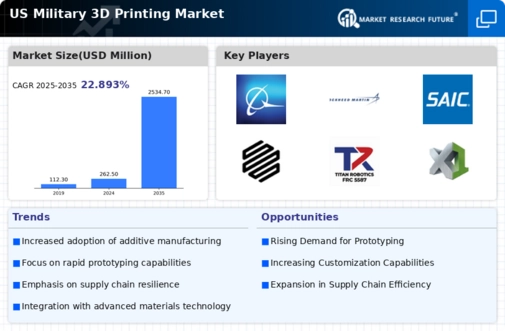The US Military 3D Printing Market has gained significant attention in recent years as advanced technologies reshape traditional manufacturing processes within defense operations. This sector is characterized by rapid innovation, with various companies vying for a competitive edge through research and development, strategic partnerships, and the deployment of cutting-edge 3D printing capabilities. The market has been driven by the demand for lightweight, customized components, rapid prototyping, and a focus on cost efficiency. Military applications range from prototyping equipment and components for aircraft to spare parts for vehicles, highlighting the versatility and efficiency of 3D printing.
Within this evolving landscape, several key players stand out for their strategic initiatives and technological advancements aimed at improving military readiness and operational effectiveness.Raytheon Technologies holds a significant position within the US Military 3D Printing Market, leveraging its strengths in advanced materials and engineering capabilities to enhance military manufacturing processes. The company's focus on integrating 3D printing to optimize supply chains and develop complex parts reflects its commitment to innovation and reducing lead times. With a robust research and development framework, Raytheon Technologies has effectively collaborated with military branches to tailor 3D printed solutions, enhancing their operational capabilities.
The company maintains a strong market presence due to its established reputation in defense and aerospace sectors, which allows it to achieve considerable influence when promoting 3D printing applications. Raytheon Technologies' investments in additive manufacturing technologies signify its dedication to staying ahead in a competitive landscape, enhancing both its offerings and the military's operational efficiencies.Boeing is another prominent player in the US Military 3D Printing Market, leveraging its extensive expertise in aerospace and defense to integrate advanced manufacturing processes into its operations.
The company has developed a range of key products and services that utilize 3D printing technology, including customized parts for military aircraft and drone systems. Boeing's strong market presence is bolstered by its strategic focus on innovation and the integration of additive manufacturing into its supply chain, facilitating faster production processes and reducing costs. The company has also engaged in various mergers and acquisitions to enhance its technological capabilities and expand its 3D printing portfolio.
Its research initiatives and collaborations with defense agencies illustrate Boeing's commitment to advancing military applications of 3D printing, allowing for agile and efficient responses to national defense needs. Through continuous investment in state-of-the-art technologies, Boeing continues to reinforce its position as a leader in the US Military 3D Printing Market.





















Leave a Comment